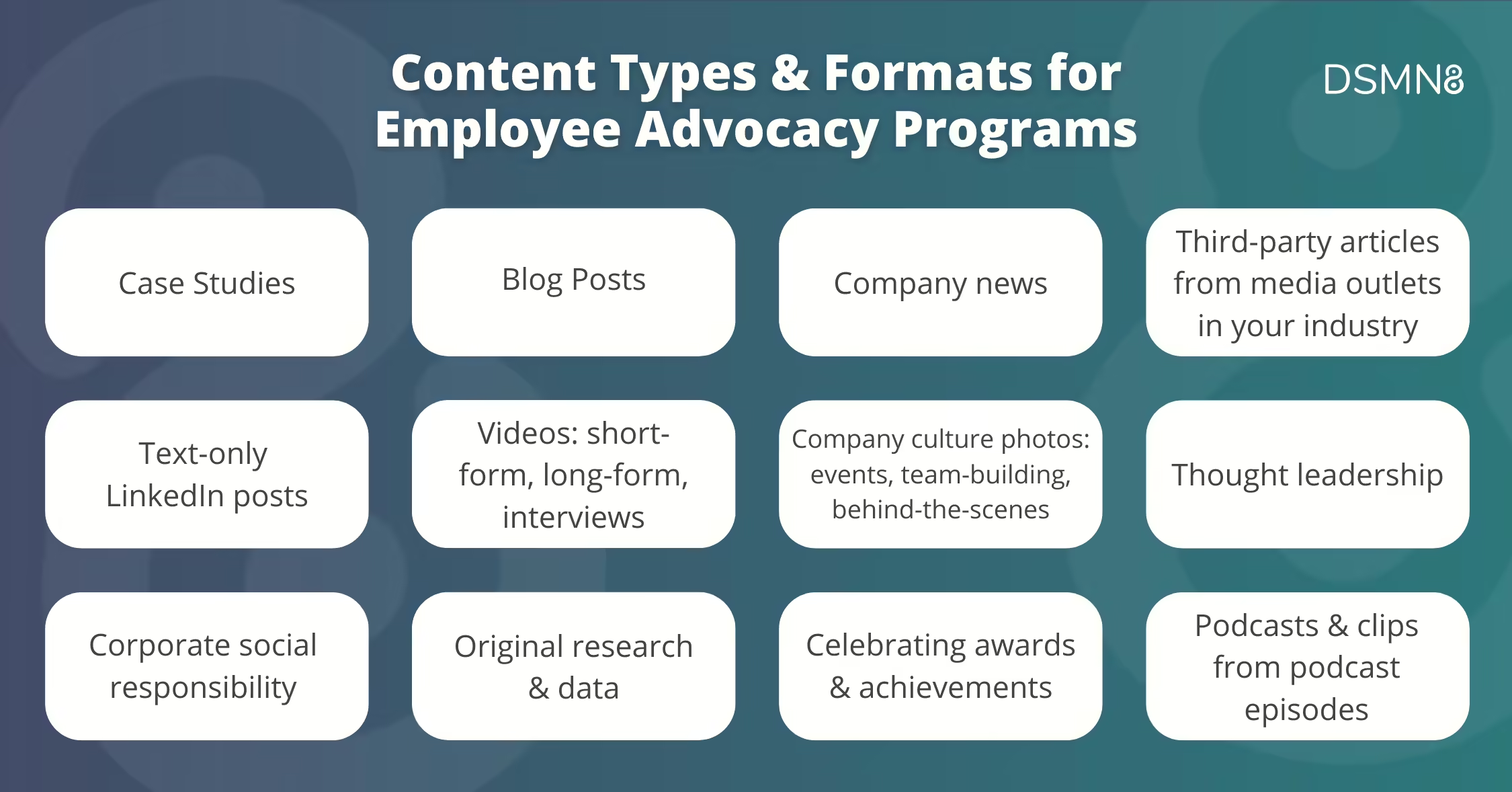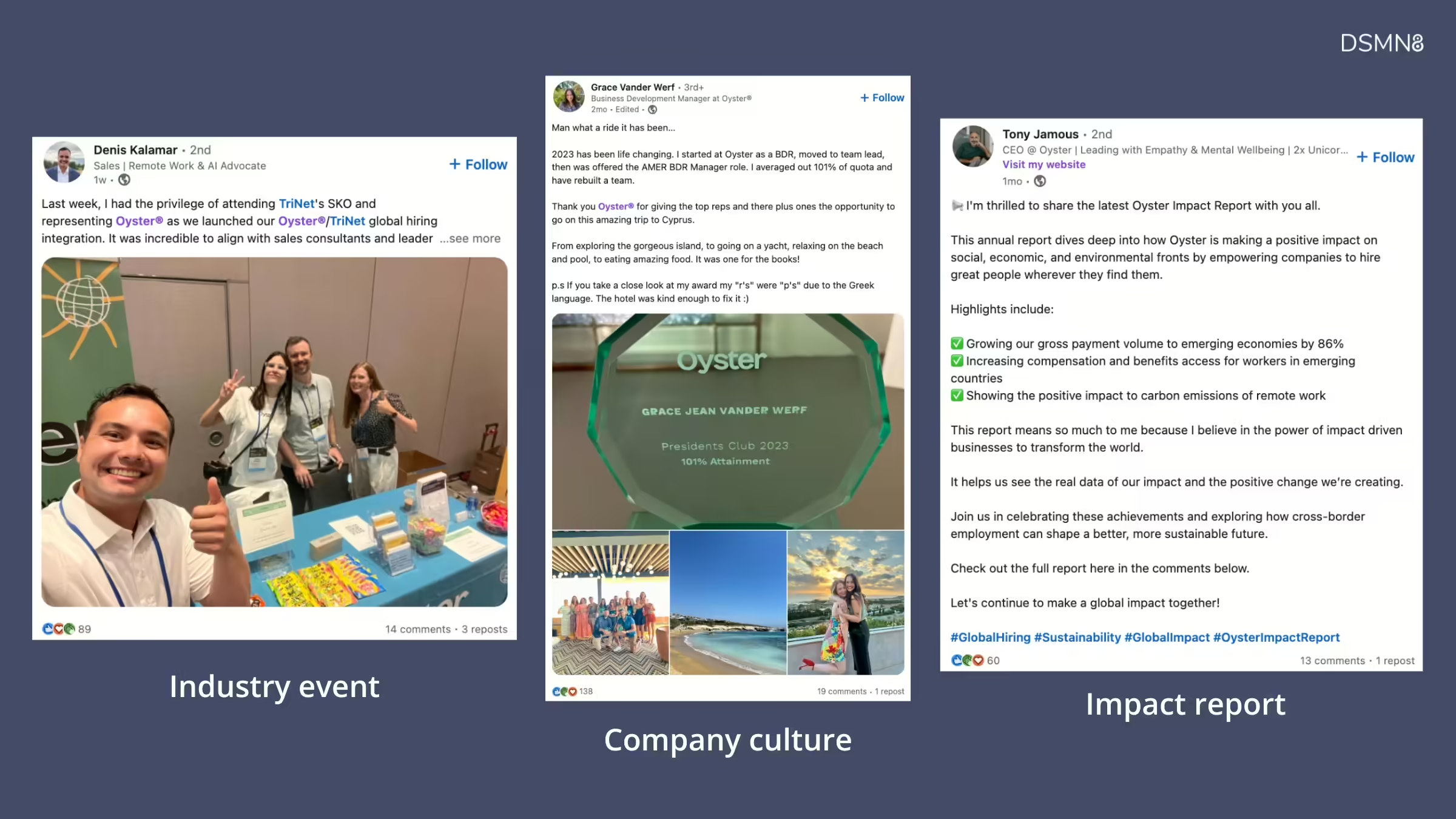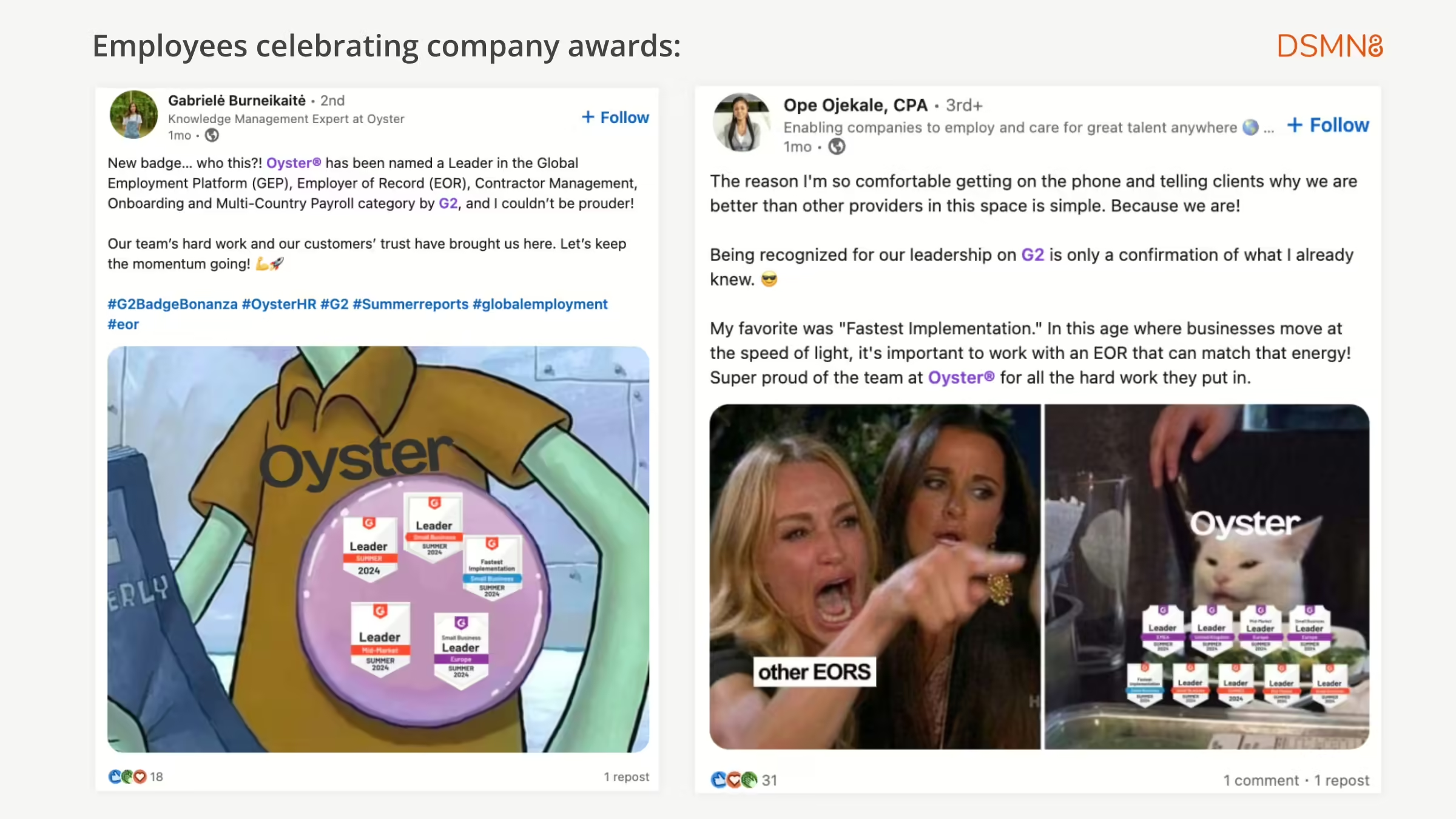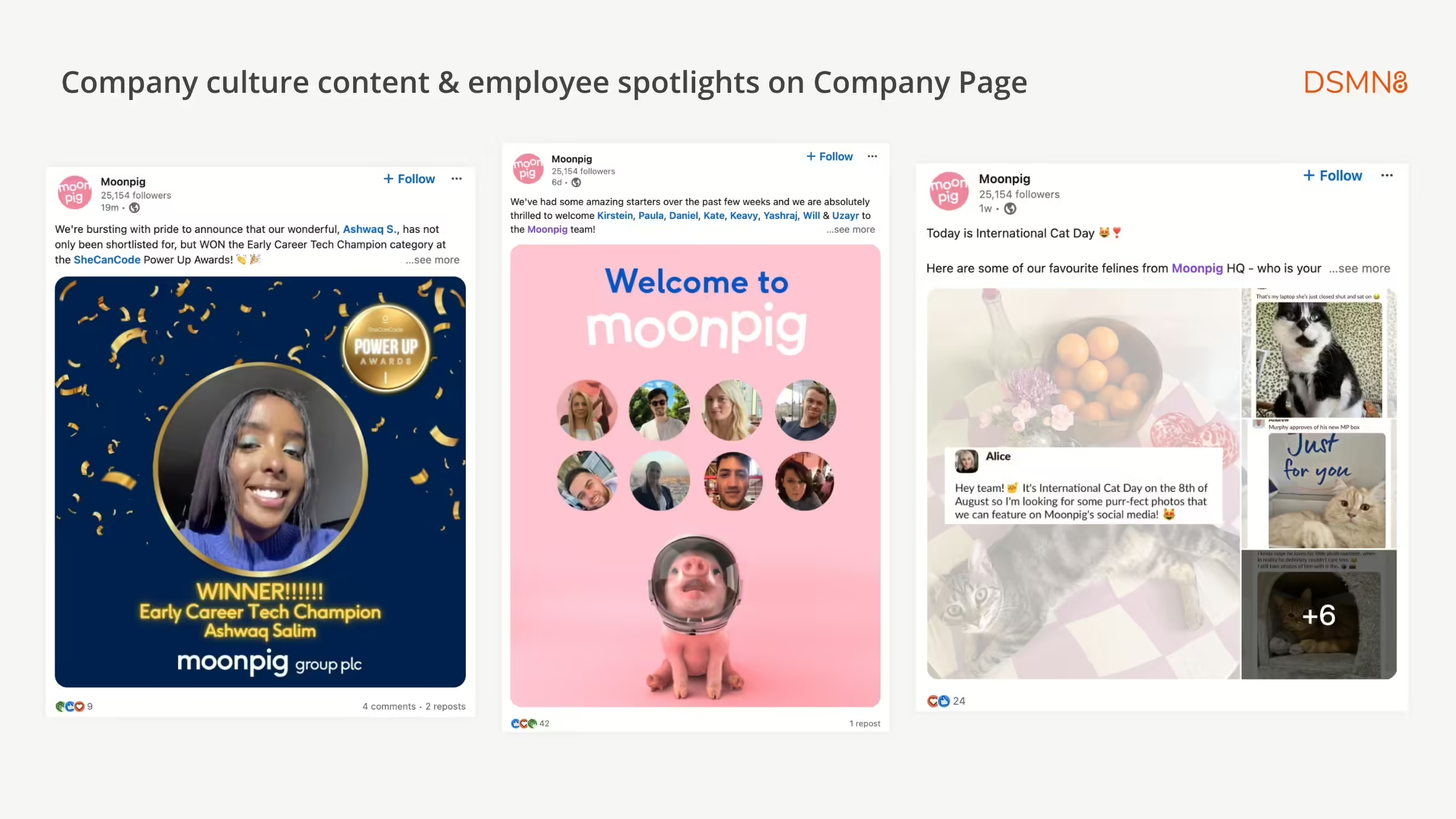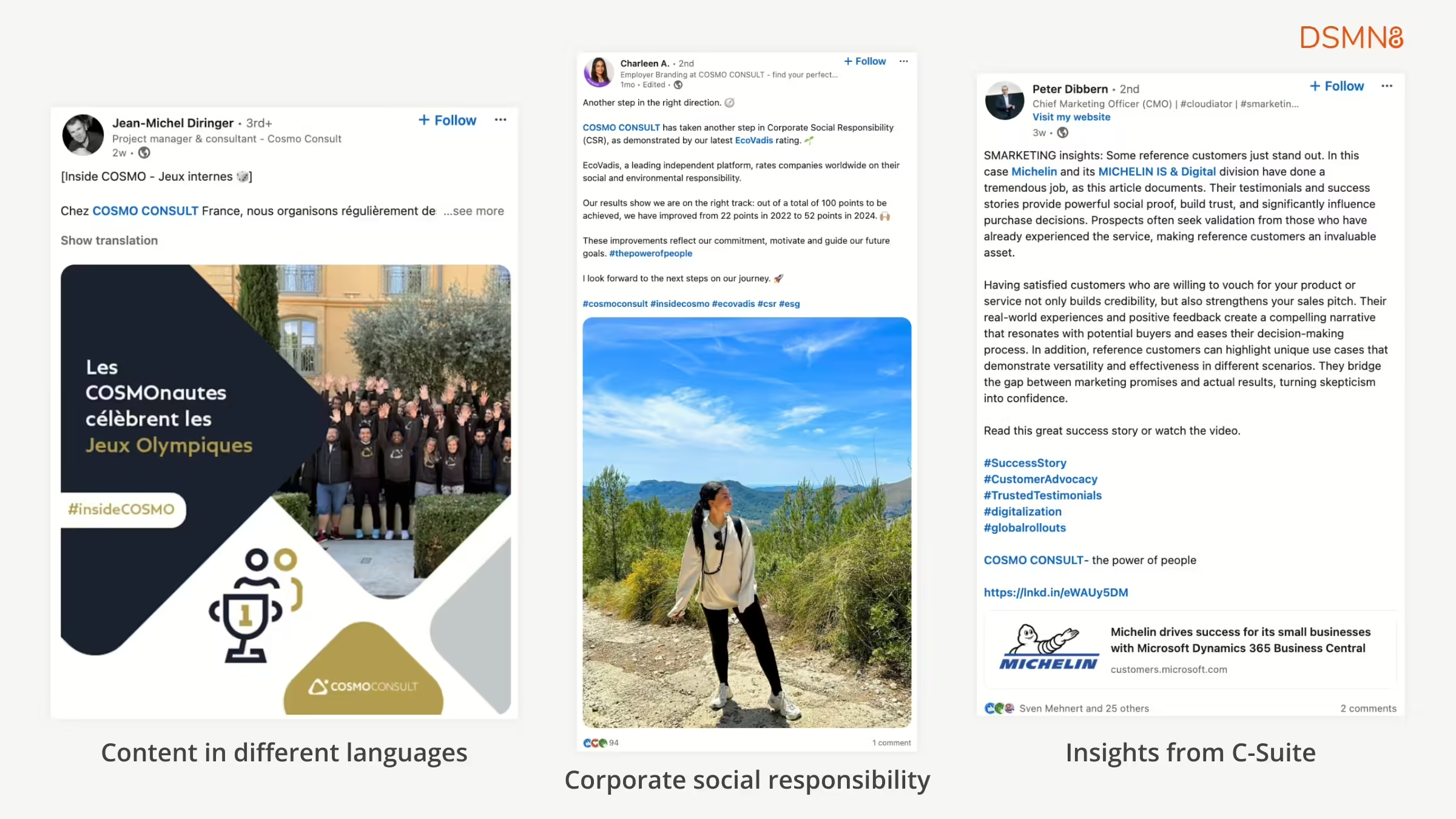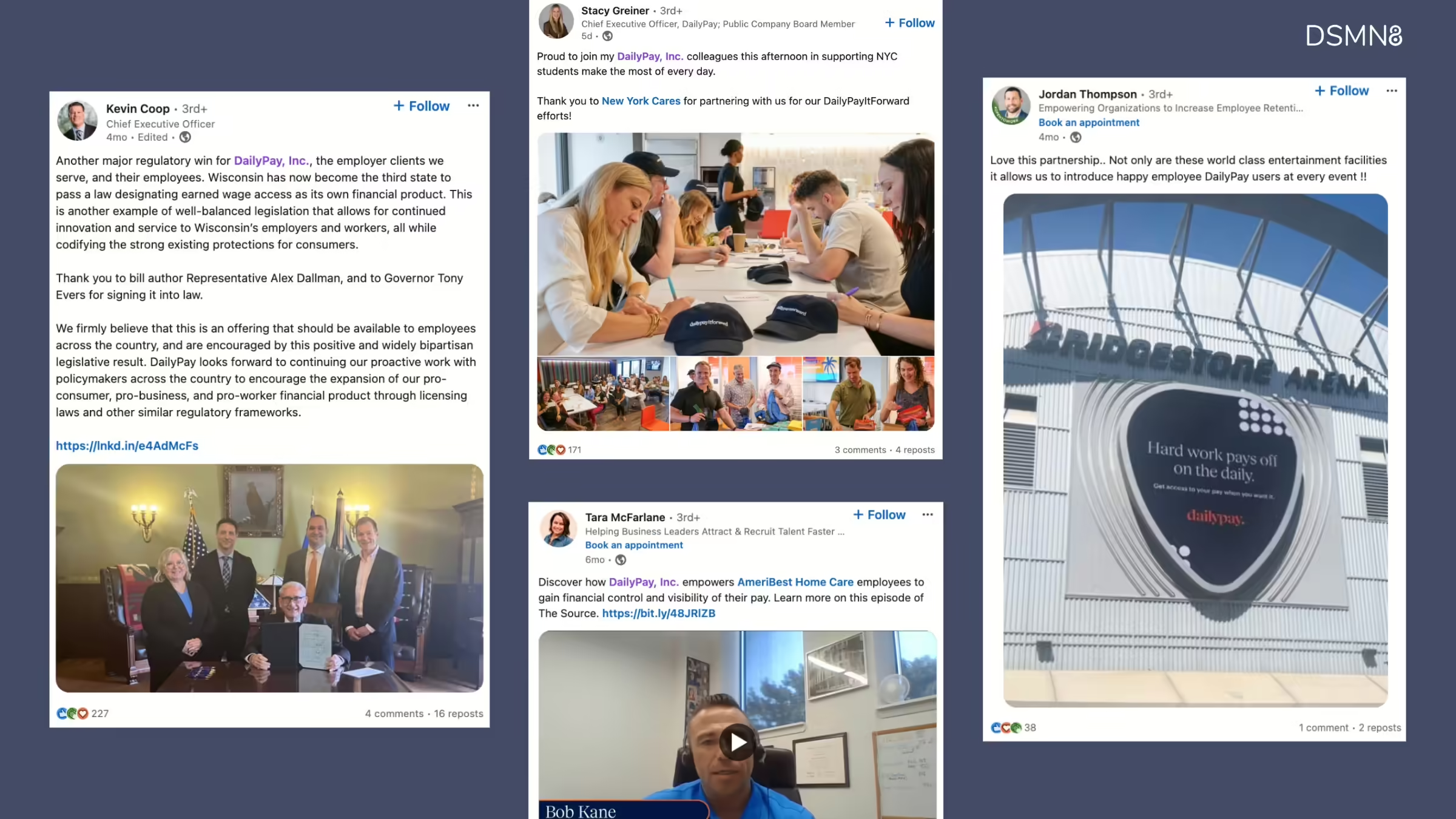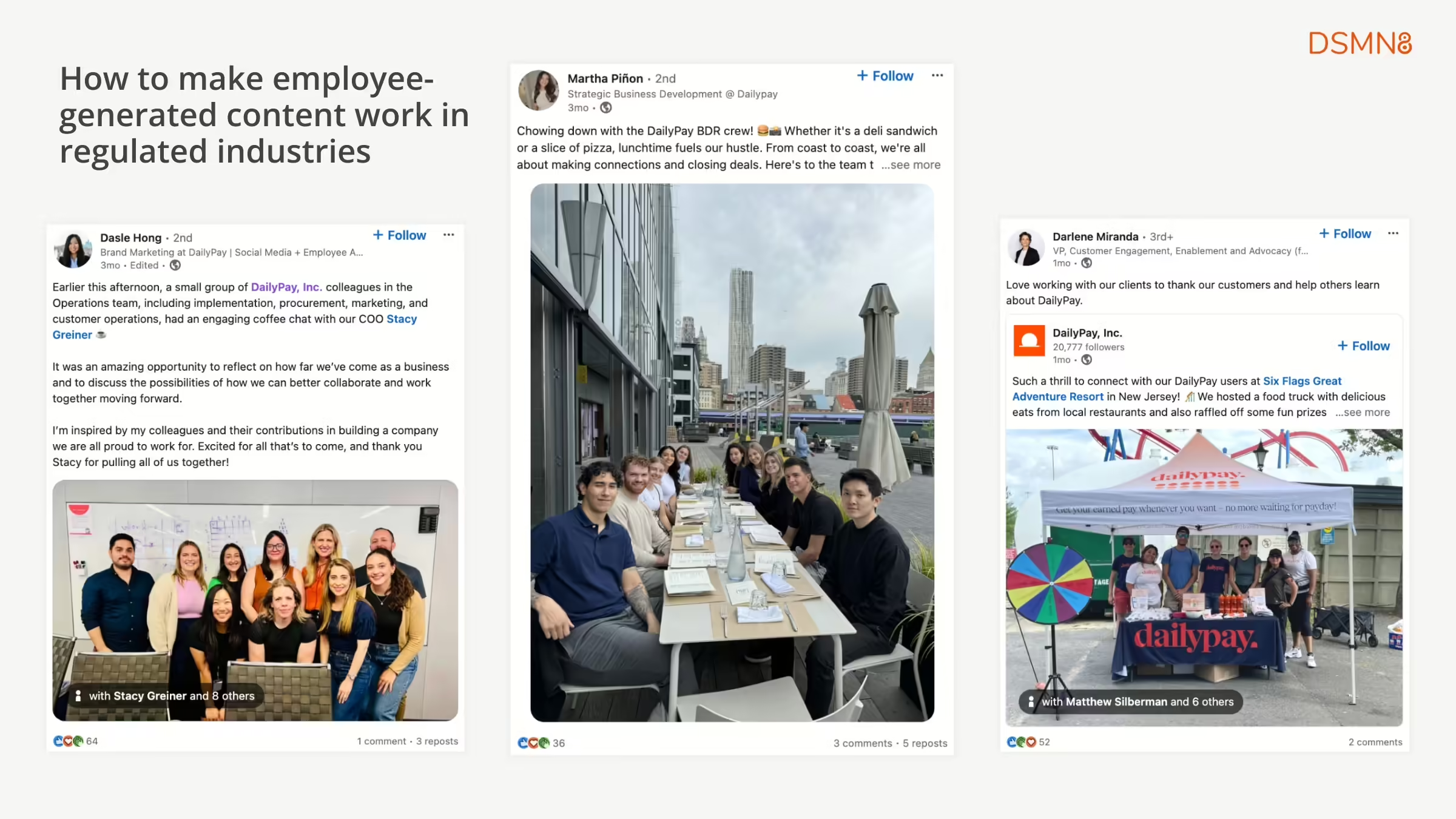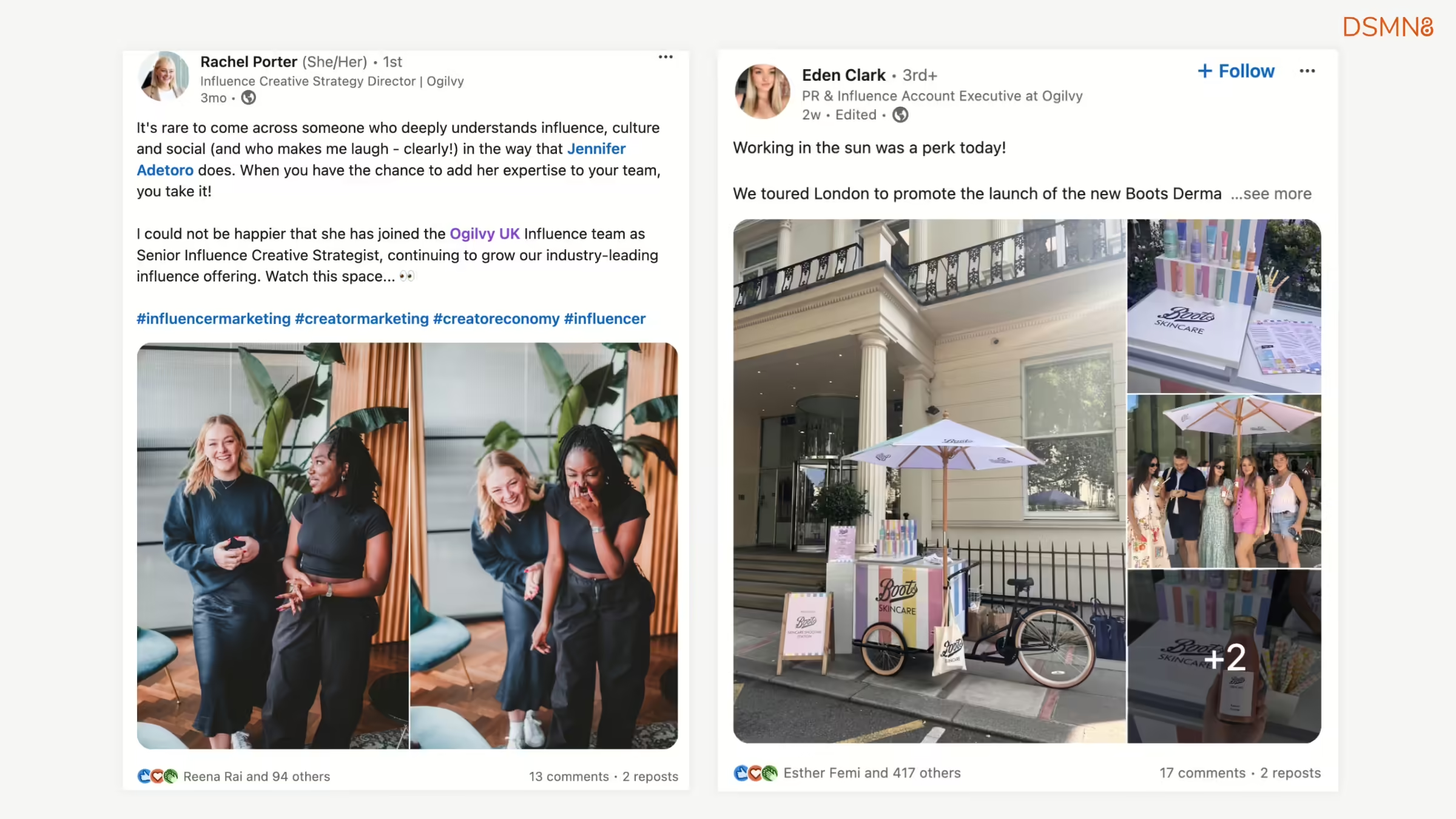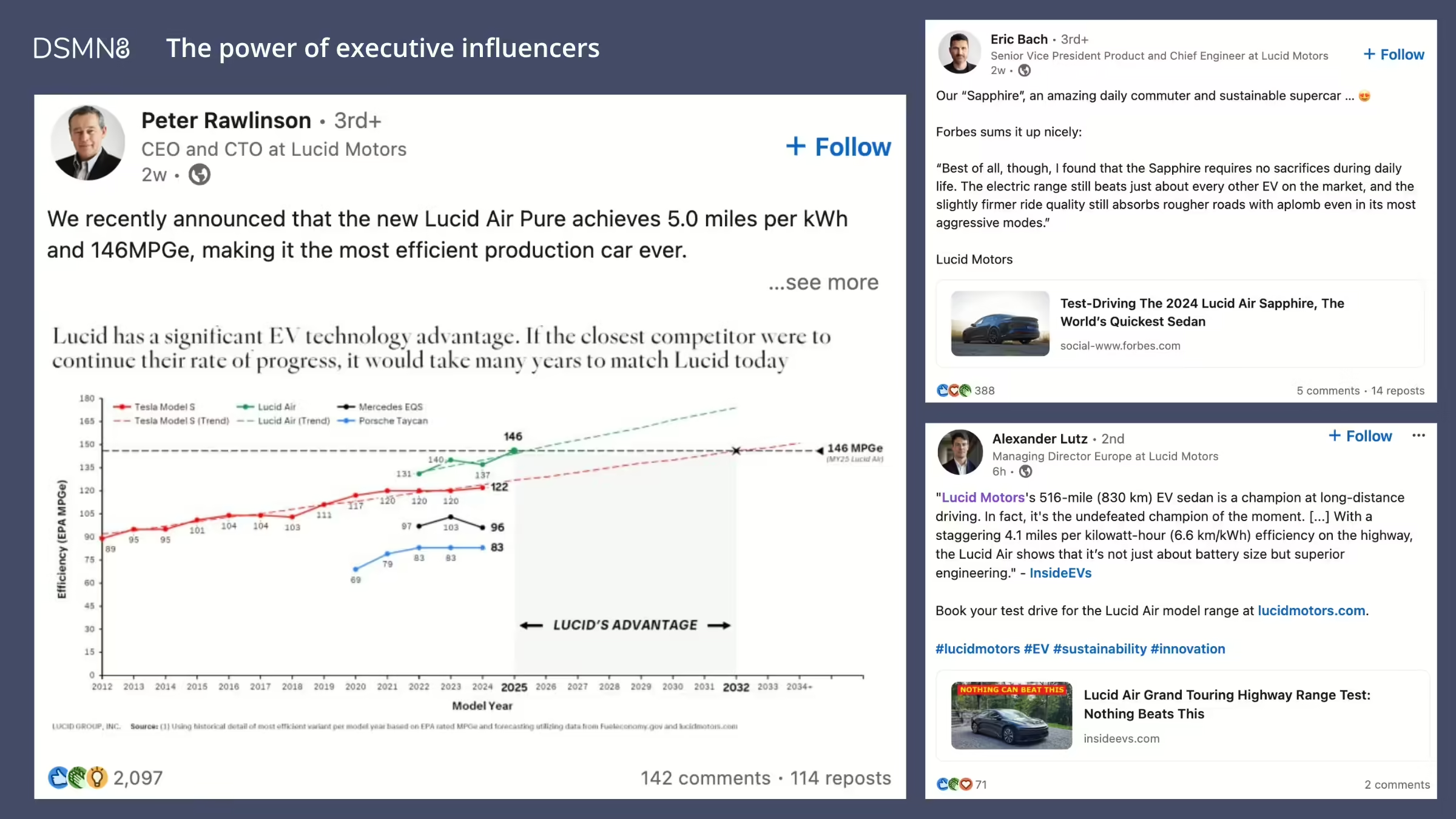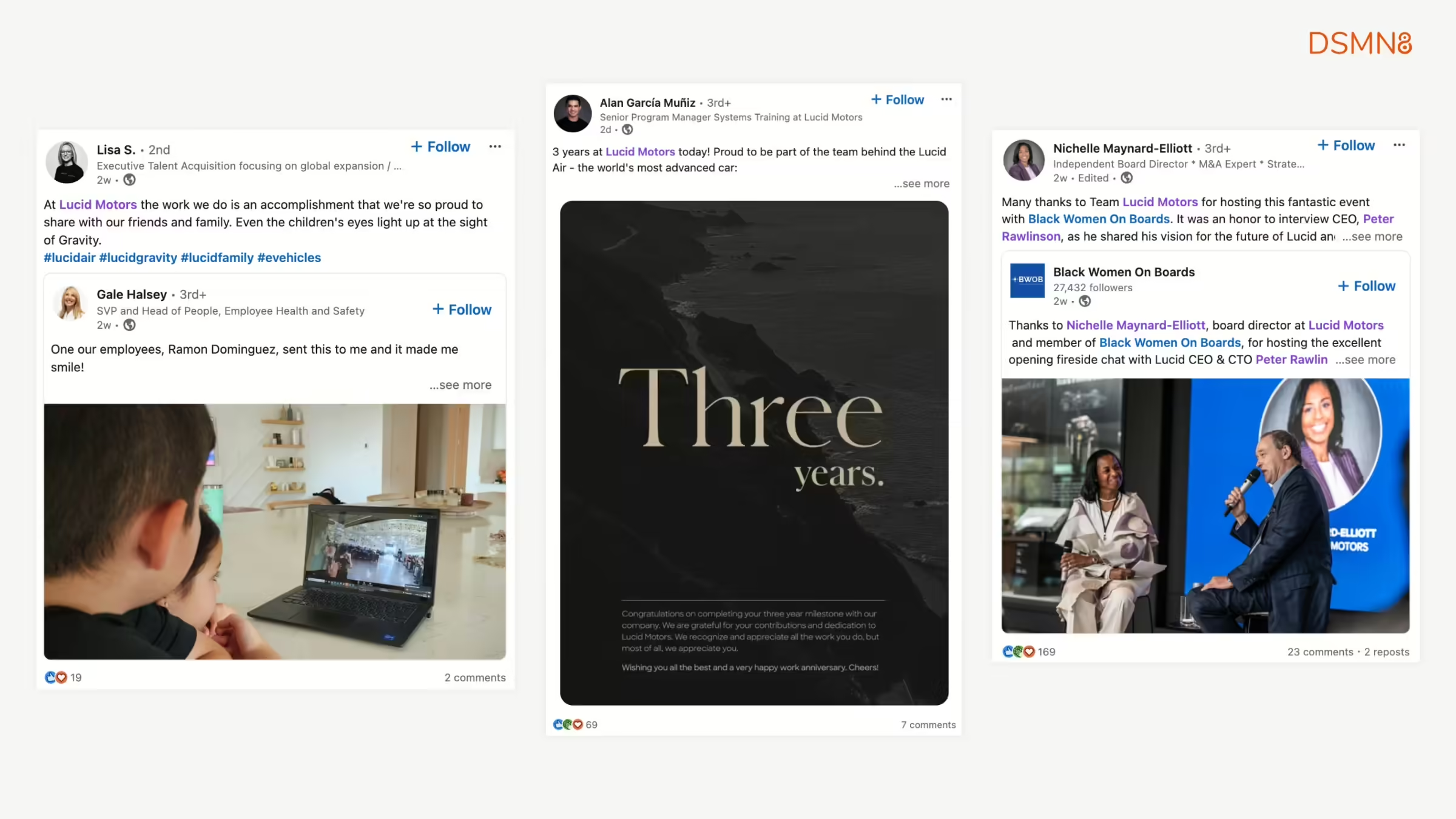
Last updated: 29th August 2025.
Thinking about launching an employee advocacy program or looking for fresh inspiration to keep yours thriving? You’re in the right place.
We’ve pulled together standout examples from companies of all sizes, across both B2B and B2C industries, to show how employee advocacy can drive impact in any organization.
Employee Advocacy Examples: Content Types & Formats
Before diving into the examples, let’s start with the goal. Employee advocacy content should aim to:
- Represent your organization as a great place to work.
- Demonstrate your company values.
- Showcase corporate social responsibility initiatives.
- Highlight employee expertise and position them as thought leaders.
- Share relevant company news & product updates to build brand awareness and drive sales.
To achieve this, create on-brand content for your team to share, but with a personal twist for their networks. Encourage your team to add their own experience, insights, and photos for authenticity.
When planning content, ask employees to contribute ideas and share their preferences.
That way, if you discover that your colleagues aren’t interested in sharing short-form videos for example, you can focus your energy on writing great articles and social posts instead. Establishing a feedback loop is essential for ensuring long-term success.
If your organization is already using a platform like DSMN8, your analytics will also reveal which content employees (and their networks) are most interested in, making it easy to adjust your content strategy in a data-driven way.
Content types and formats for employee advocacy programs:
- Case Studies.
- Blog Posts.
- Videos (short-form, long-form, interviews).
- Text-only LinkedIn posts.
- Podcasts and clips from podcast episodes.
- Company news.
- Third-party articles from media outlets in your industry.
- Original research & data.
- Company culture photos: events, team-building, behind-the-scenes.
- Corporate social responsibility.
- Celebrating awards & achievements.
- Thought leadership.
That said, here are some more specific employee advocacy program content ideas:
- Feature your subject matter experts in your company podcast, or ask them to write a blog post. Provide social media captions for employees to easily share it.
- Encourage employees to take and share photos from company events. This highlights your company culture, supporting employer branding efforts.
- Source relevant third-party articles for your team to share. This shows that they’re up-to-date on industry news and trends.
- Create thought leadership content for your C-Suite executives. This positions them as experts, and generates huge engagement on social media.
- Launching a new product? Encourage those who worked on it to share the news on LinkedIn.
- Hiring? Make sure that employees in the department are sharing the job listing with their networks.
Let’s take a look at 7 organizations doing this well! 👇
1. Oyster HR
Industry: Human Resources Services
Employees: 600+
LinkedIn Company Page
Oyster makes it possible for employers to hire people anywhere in the world, providing a platform to onboard, pay and manage remote employees.
With their focus on remote work, it’s no surprise that their employees regularly share content on LinkedIn about the benefits of having an international team, alongside photos from events and employee meetups across the globe.
Why We Love It
Oyster employees come across as enthusiastic and engaged in their LinkedIn posts. They often celebrate company awards such as G2 badges and internal recognition, and share behind-the-scenes photos from events.
Employee content at Oyster is authentic and aligns with their fun and modern branding. The use of memes, emojis, and original posts feels genuine, making it easy for readers to connect with the brand.
Oyster’s CEO, Tony Jamous, shares valuable insights concisely, for example, by sharing the key takeaways from an Impact Report (pictured above). This approach works well on social media, as most users won’t read an essay on their feed!
2. Moonpig
Industry: Online Retail (Cards, Gifts, Flowers)
Employees: 450+
LinkedIn Company Page
Moonpig is a popular online retail brand here in the UK. They provide greeting cards, gifts and flowers for special occasions.
Their LinkedIn isn’t geared towards customers (they use platforms like Instagram for that!), but rather, it’s focused on employer branding for talent acquisition.
Scroll through Moonpig’s company page, and you’ll find a positive and joyful company culture: an organization that celebrates employee successes, welcomes new team members, and shares pictures of their pets.
Why We Love It
I want to highlight Moonpig’s Product Team specifically as a great example of empowering employees to share their expertise and build personal brands.
Team members at Moonpig not only announce their projects, showing pride in their work, but also actively support and congratulate each other publicly. This supportive culture reflects the company’s values and enhances its employer branding.
The team, from Designers to Product Managers, create helpful articles for their Product Blog and share them on LinkedIn. They demonstrate expertise while offering guidance to others in the industry.
The takeaway? Being genuinely helpful is the best way to stand out on social media and build your network.
3. COSMO Consult
Industry: IT Services and IT Consulting
Employees: 1,300
LinkedIn Company Page
DSMN8 client COSMO Consult are pros at employee advocacy.
As one of the world’s leading providers of end-to-end solutions, they support companies with digital transformation with a forward-thinking approach.
After implementing the DSMN8 platform, social media became part of their day-to-day activities, showcasing COSMO’s incredible company culture with employee networks.
Why We Love It
The main reason COSMO Consult stands out is their personalized approach to employee advocacy program content.
They create unique pieces in multiple languages, topics, and personas. This provides employees with many options to choose from, while enabling them to reach target demographics across the globe.
Peter Dibbern, Chief Marketing Officer explains:
“In order to optimize our outreach and bandwidth, we use DSMN8 to distribute individualized content to target groups, buying centers and concrete personas, measuring the impact of our social media performance.” Read the full case study.
But pre-approved content isn’t the only type of employee advocacy at play here: COSMO also encourage employee-generated content. This is a great way to attract talent, by authentically representing brand values and company culture on social media.
4. DailyPay
Industry: Financial Services (FinTech)
Employees: 800+
LinkedIn Company Page
DailyPay is a software provider in the financial services industry. Their product enables employers to pay employees based on the employee’s own needs and schedules. They aim to support employee wellbeing, keeping them more engaged, motivated and happier at work.
Employees from various departments, including senior leadership, board members, sales and marketing, regularly share content on LinkedIn.
Their content isn’t just company news: they post everything from podcast episodes and brand partnerships to workshops with students and regulatory information.
Why We Love It
DailyPay provides an excellent example of how to make employee-generated content work in regulated industries.
Employees in this sector should be cautious when taking photos at work due to the risk of sharing confidential information.
Instead, the DailyPay team focus on their company culture: sharing photos from team lunches, group photos after meetings, and pictures from external events.
5. SEPHORA Canada
Industry: Retail
Employees: 42,000
LinkedIn Company Page
Sephora is a multinational retailer of beauty and personal care products, owned by luxury goods conglomerate LVMH (Moët Hennessy Louis Vuitton).
The world of beauty retail is all about influencer marketing these days, leveraging the audiences of content creators and ‘beauty gurus’ to drive sales and build brand awareness.
But what if you could empower your own employees to become influencers?
That’s exactly what Sephora Canada did.
Their ‘SPARK’ employee ambassador program (standing for Storytelling, Passion, Allyship, Respect, Knowledge) is an award-winning employee advocacy program.
A select group of employee influencers are trusted to showcase their experience as an employee, both internally and externally.
Why We Love It
Content by SPARK employees supports talent acquisition by highlighting the opportunities that come with a role at Sephora, such as career progression, masterclasses and personal development.
They create engaging content like ‘A Day in the Life of a Sephora Merchant at a Brand Summit’ that resonates with their target audience for employer branding: women seeking a role that empowers them.
And it’s not just those in the SPARK program that share content.
Sephora’s senior leaders regularly post on LinkedIn about events like International Women’s Day, Pride, and National Interns Day to highlight why they’re a great employer that celebrates diversity.
6. Ogilvy
Industry: Advertising Services
Employees: 11,000
LinkedIn Company Page
Unsurprisingly, advertising, marketing, and PR powerhouse Ogilvy are all about employee advocacy.
Founded in 1948 and boasting household-name clients including IBM, American Express and Dove, the agency is at the forefront of advertising innovation.
Regularly featuring in DSMN8’s Employee Social Media Activity Leaderboards, it’s clear that Ogilvy employees understand the impact that building their social media presence has on their careers as well as supporting business goals.
Why We Love It
Ogilvy employees share a wide variety of content formats and types to reach their target audiences and engage their networks.
Images, carousels, employee-generated content, articles… #TeamOgilvy do it all.
We particularly love Director of Communications Hugo Eyre-Varnier‘s press feature posts: instead of simply sharing a link, he screenshots the article and accompanies the image with his own insights.
This works particularly well with LinkedIn’s recent link preview changes.
7. Lucid Motors
Industry: Motor Vehicle Manufacturing
Employees: 5,800
LinkedIn Company Page
Finally, here’s my favorite example from the automotive industry: Lucid Motors. They’re an American electric vehicle manufacturer focused on elevating the sustainable driving experience.
Currently sitting at the top of our Automotive Employee Social Media Activity Leaderboard for the US, the Lucid Motors team is very active on LinkedIn.
Led by CEO and CTO Peter Rawlinson, employees and board directors share the latest Lucid Motors news on LinkedIn, peppered with their own photos and copy.
Why We Love It
Lucid Motors is a clear example of executives’ influence on social media—the CEO’s post featuring a graph pictured above generated over 2,000 LinkedIn reactions.
But their content isn’t all about cars.
Lucid Motors employees are clearly proud of the community they have built. The fact that they highlight this is a great recruitment driver in an industry where competition for the best talent is fierce.
Employees post heartwarming pictures showing their work to their children, celebrate work anniversaries with a graphic provided by the company, and talk about diversity events they have hosted, including Black Women on Boards.
Additional Resources
I hope you found these employee advocacy examples as inspiring as I did!
While your program’s content will vary depending on your organization’s culture, industry and many more factors, as you can see from the examples above, these fundamentals can be applied across all types of programs:
- Executives should share thought leadership and key company news on LinkedIn. They typically have the largest influence on social media, both internally and externally.
- Empowering employees to add their own insights and photos makes content more authentic and engaging.
- Showcasing company culture on social media is a key employer branding strategy to attract top talent.
For more guidance on creating great content for your team to share, check out the resources below👇
Ready to launch your own employee advocacy program?
Schedule a call with one of the team.
Prefer to cut to the chase and explore the platform?
Roger that!
Book a demo of DSMN8, the #1 Employee Advocacy Platform.
Emily Neal
SEO and Content Specialist at DSMN8. Emily has 10 years experience blogging, and is a pro at Pinterest Marketing, reaching 1 million monthly views. She’s all about empowering employees to grow their personal brands and become influencers.

